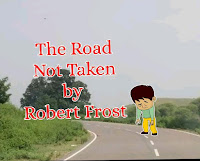Mending Wall|Robert Frost|Summary&Analysis
 |
| Mending Wall|Robert Frost |
The famous poem "Mending Wall' was composed by the American poet Robert Frost. It was composed in 1913 and published in the second volume of his poems "North of Boston" in 1914. This poem is written in blank verse. It has 46 lines. It is a narrative poem.
It describes the story of two villagers of New England. In this poem, the poet describes the customs, beliefs and traditions of the villagers living in the countryside.
It describes the story of two villagers of New England. In this poem, the poet describes the customs, beliefs and traditions of the villagers living in the countryside.
The poem "Mending Wall" is a poem related to the mending or repairing of a wall between two fields in a village. There are two farmers who are owners of these two farms. In this poem, one farmer is a young man and the other is an old man. So there is the difference between their thoughts.
Their thinking was totally different from each other. There was a conflict between them related to the mending of a wall between their farms. Actually, the old farmer wanted to make a wall between their fields but the young farmer did not want.
Therefore there was the dispute between them. In this poem, there was a conflict between the thinking of two generations new and old.
According to the young farmer, there is no need for the wall but the old farmer favours the need for a wall between their farms. As we study the poem it shows the practice of repairing the wall between two farms.
Their thinking was totally different from each other. There was a conflict between them related to the mending of a wall between their farms. Actually, the old farmer wanted to make a wall between their fields but the young farmer did not want.
Therefore there was the dispute between them. In this poem, there was a conflict between the thinking of two generations new and old.
According to the young farmer, there is no need for the wall but the old farmer favours the need for a wall between their farms. As we study the poem it shows the practice of repairing the wall between two farms.
The young farmer says that there is a supernatural power at work to remove the wall between their field. Therefore frost brings down the stones of the wall. The young man also says that it is not the work of hunters.
The poet further says that every year in spring season the holes appear again in the walls and both the farmers repair the wall on their respective sides.
On the other hand, the young farmer says that there is no need for making the wall as their fields are already divided by nature. Their crops are different. one has apple trees and other has pine trees in their field.
On the other hand, the young farmer says that there is no need for making the wall as their fields are already divided by nature. Their crops are different. one has apple trees and other has pine trees in their field.
The young man again asks the old man why this wall is needed between their fields. After all, they are good neighbours. They do not need this type of barrier between them. After some time the old man comes with two stones in his hands. He seems to the young man like a wild beast of the stone age.
According to the young man, the old man was uncivilized. The old man believed in orthodoxy because according to the old man there should be wall to keep good relations with neighbours. The old man always said that "Good fences are good neighbours".
Thus the poet shows the narrowness of old people. As we are living in the age of science and modernity. There is no space for old narrow ideas and orthodoxy. There is a need for universal brotherhood.








